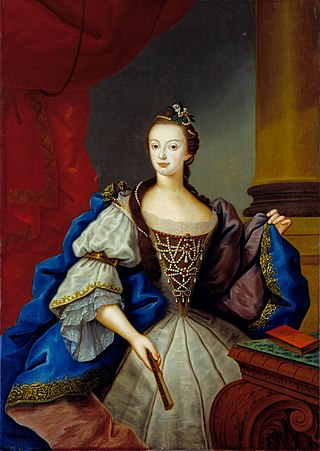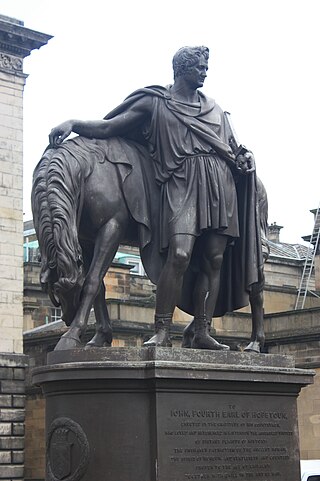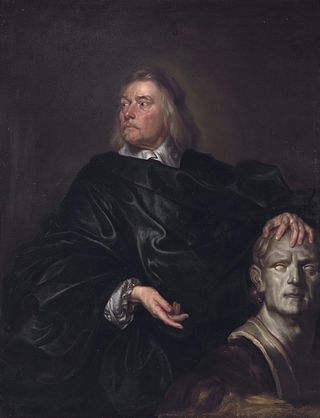
John Cheere (1709–1787) was an English sculptor, born in London. The younger brother of the sculptor Sir Henry Cheere, he was originally apprenticed as a haberdasher from 1725 to 1732.

John Cheere (1709–1787) was an English sculptor, born in London. The younger brother of the sculptor Sir Henry Cheere, he was originally apprenticed as a haberdasher from 1725 to 1732.
He was born in Clapham the son of Sarah and John Cheere. Around 1722 he joined his brother Henry Cheere in the sculpture yard of John Nost and when Henry set up his own yard around 1730, John joined him as a partner. However, in 1739 John returned to Nost's yard which had been unused or underused since Nost's death in 1729. John bought the yard and a number of lead moulds for casting lead statues (which were normally painted in those days). [1]
He is now mainly remembered as a creator of lead statues standing in the gardens of stately homes. Some of these (other than the casting) logically may be the artistic work of Nost rather than Cheere. These kinds of sculptures were popular for the summer houses of the 18th century’s aristocracy. [2]
Some were reproductions of classical Roman or Greek sculptures, but there was also a demand for statues depicting simple, pastoral themes. [3]
Several of the sculptures from Queluz had not been on public view since 1967, and have been restored by Rupert Harris Conservation, in London, and returned to Portugal in May 2009. [4] This restoration was in part made possible by the World Monuments Fund Britain. [5]
The Medici lions at Stowe House have been attributed to Cheere. [6]
He died in 1787 and was buried in Clapham with his first wife. [7]

His first wife, Theodosia Maria, was from the parish of St. Georges near Hanover Square, London, but died in May 1767, soon after the death of both her father and only son. He then married Mary Wilmot of Clapham on 30 June 1768. They had no children. On Cheeere's death he left his assets to a nephew, Charles Cheere. [9]

Louis-François Roubiliac was a French sculptor who worked in England. One of the four most prominent sculptors in London working in the rococo style, he was described by Margaret Whinney as "probably the most accomplished sculptor ever to work in England".

William John Coffee (1774–1846) was an internationally renowned English artist and sculptor who worked in porcelain, plaster, and terra cotta. He also worked in oil paint, although this was not the medium for which he became famous. His early career was as a modeller for William Duesbury at the china factory on Nottingham Road in Derby, England. The latter part of his life was spent in America.

The Palace of Queluz is an 18th-century palace located at Queluz, a city of the Sintra Municipality, in the Lisbon District, on the Portuguese Riviera. One of the last great Rococo buildings to be designed in Europe, the palace was conceived as a summer retreat for King José I's brother, Pedro of Braganza, later to become husband and king jure uxoris to his own niece, Queen Maria I. It eventually served as a discreet place of incarceration for Maria I, when she became afflicted by severe mental illness in the years following Pedro III's death in 1786. Following the destruction of Ajuda Palace by fire in 1794, Queluz Palace became the official residence of the Portuguese Prince Regent João, and his family, and remained so until the royal family fled to the Portuguese colony of Brazil in 1807, following the French invasion of Portugal.

Melbourne Hall is a Georgian style country house in Melbourne, Derbyshire, previously owned by William Lamb, 2nd Viscount Melbourne, British Prime Minister from 1835 to 1841. The house is now the seat of Lord and Lady Ralph Kerr and is open to the public. The house is a Grade II* listed building; more than twenty features in the grounds are Grade I listed.

Francis Bird (1667–1731) was one of the leading English sculptors of his time. He is mainly remembered for sculptures in Westminster Abbey and St Paul's Cathedral. He carved a tomb for the dramatist William Congreve in Westminster Abbey and sculptures of the apostles and evangelists on the exterior of St Paul's, a memorial to William Hewer in the interior of St Paul's Church, Clapham as well as the statue of Henry VI in School Yard, Eton College. Despite his success, later in life Bird did little sculpting. He had inherited money from his father-in-law and set up a marble import business.

John Nost was a Flemish sculptor who worked in England in the late 17th and early 18th centuries.
Prince Hoare was an English sculptor. "Prince" in this instance was a given name, not a royal title.
Sir Henry Cheere, 1st Baronet was a renowned English sculptor and monumental mason. He was the older brother of John Cheere, also a notable sculptor.

George Bullock (c.1777–1818) was a sculptor and furniture-maker working in Liverpool and London.
John Hickey (1751–1795) was an Irish sculptor.
Alexander Handyside Ritchie was a Scottish sculptor born in Musselburgh in 1804, the son of James Ritchie, a local brickmaker and ornamental plasterer, and his wife Euphemia. The father in turn was the son of a fisherman and amateur sculptor.

Thomas Campbell was a Scottish sculptor in the early 19th century. He has several important public works, most notably a statue of Sarah Siddons in Westminster Abbey. He also has several works in the National Gallery in London. He was heavily patronised by the British aristocracy, as evidenced by his works.

James Sherwood Westmacott (1823–1900) was a British sculptor during the 19th century and part of the Westmacott dynasty stemming from Richard Westmacott.

John van Nost the younger (1713-1780) was the nephew of the noted Flemish-born British sculptor John van Nost and a noteworthy sculptor in his own right.
Richard Hayward (1725–1800) was an 18th-century British sculptor. He has several works in Westminster Abbey.

Edward Pierce or Pearce (1630–1695) was a 17th century English sculptor and architectural sculptor. He was also an avid collector of books, drawings and plaster figures.
Edward Davis MIBS was a 19th century British sculptor.
William Spence (1793–1849) was an early 19th century British sculptor.
Charles Raymond Smith (1798–1888) was a 19th-century British sculptor.
James Heffernan was an 18th/19th century Irish-born sculptor, later based in London.